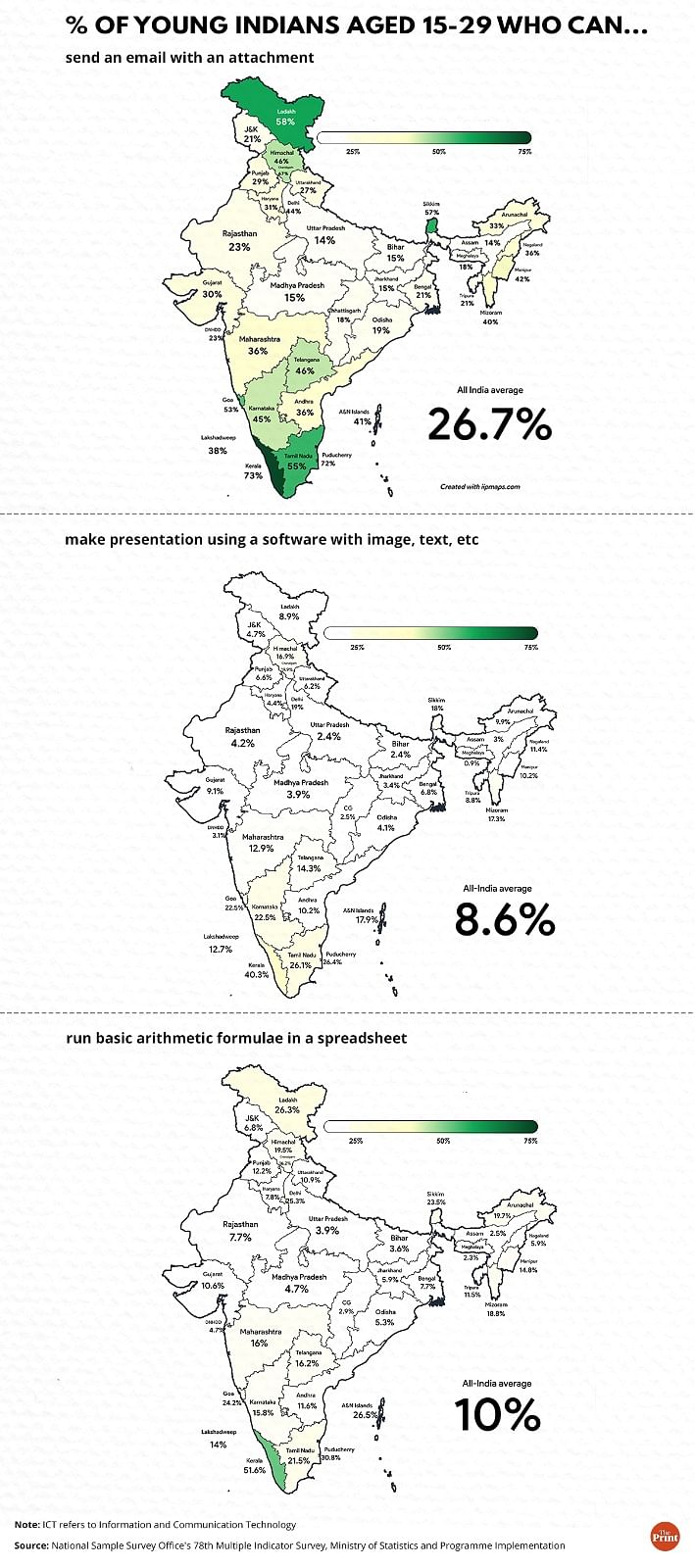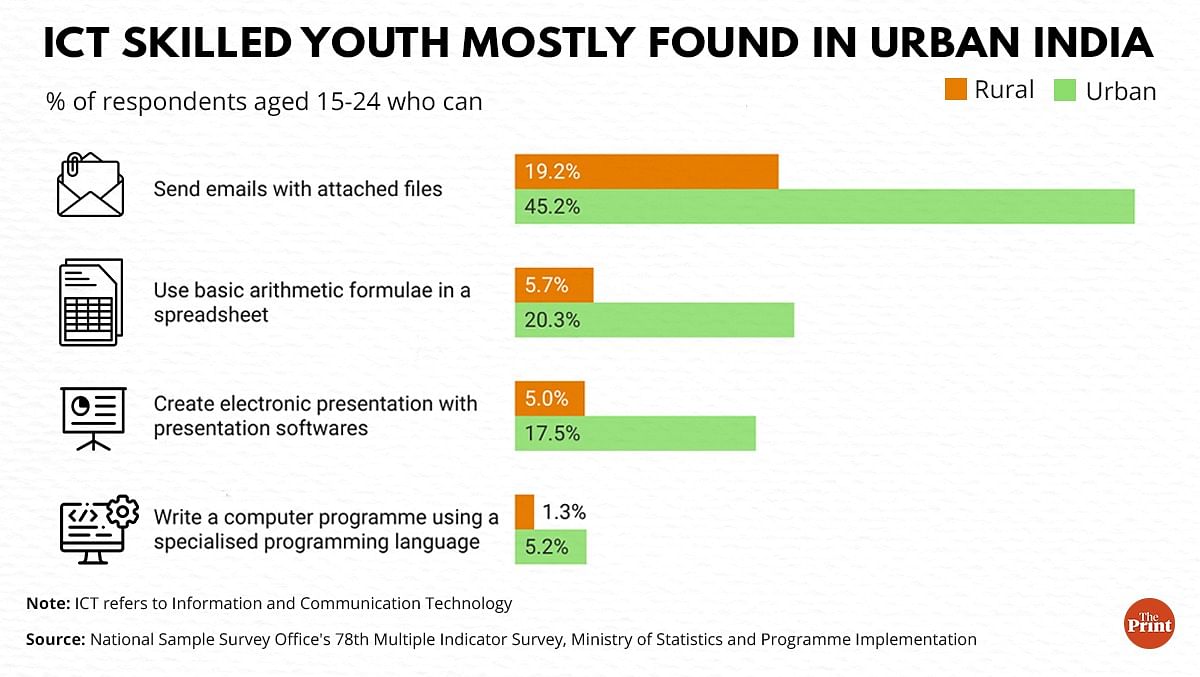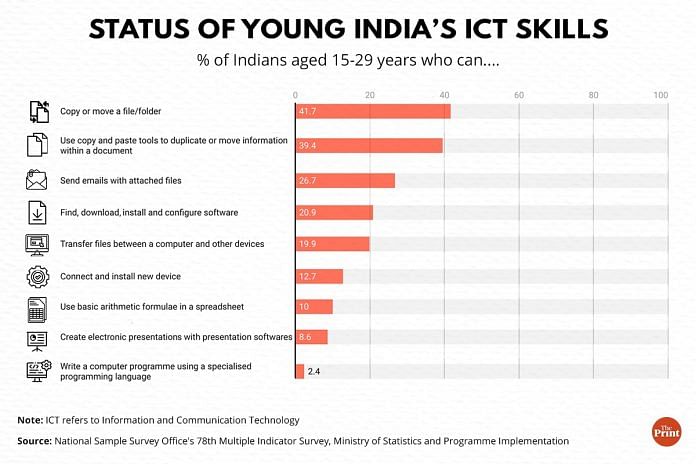New Delhi: India aspires to become a trillion-dollar digital economy by 2025, but most young Indians do not even know how to send an e-mail attachment or perform other basic computer functions, suggests the latest Multiple Indicator Survey (MIS) report of the National Sample Survey Office (NSSO), released earlier this month.
Conducted in 2020-21 with an overall sample size of over 11 lakh respondents across the country, the NSSO survey, under the aegis of the Ministry of Statistics and Programme Implementation (MoSPI), primarily aims to collect data on various national indicators of the UN’s Sustainable Development Goals which aim to achieve economic growth and meet social needs while addressing climate change and taking care of environmental protection.
To ascertain the information and communication technology (ICT) skills of people in the 15-29 age group, the survey asked respondents to self-report whether they could perform nine activities on a computer. The report did not state how many respondents came under this age group.
In response to a set of questions, most participants indicated an inability to perform relatively routine tasks. Barely 27 per cent said they knew how to send an e-mail with attachments, only 10 per cent said they could use basic arithmetic formulas in a spreadsheet, and a mere 9 per cent said they could create an electronic presentation using any software.
The numbers were even more dismal for comparatively complex skills which require some specialised knowledge. For instance, over 97 per cent of respondents said they did not know how to write a computer programme using a programming language.
This suggests that though India aims to be an IT hub for the world — President Droupadi Murmu while speaking at the Digital India Awards earlier this year said the country should strive to become a hub for software products — only a minuscule percentage of the population can actually write codes. Further, just over 20 per cent of respondents said they could manage to find, download, install, and configure software and only 12 per cent claimed they could connect and install a new device such as a printer or camera.
According to MoSPI’s 2021 projections, the 15-29 age group represents more than a quarter of India’s population, around 27.5 per cent. The lack of ICT skills in this young working-age population, as indicated by the survey, does not bode well for the future prospects of many in an increasingly digitised world, feel experts.
“A larger pool of people with low ICT skills further paves the way for exclusion of impoverished groups in our society — those who cannot afford internet, computer systems, or training,” said professor Archana Prasad of Jawaharlal Nehru University’s Centre for Informal Sector & Labour Studies, speaking to ThePrint.
She added: “As more and more jobs go online or are digitised, the narrower the entry to India’s job markets will become, making it tougher for people in the lower strata to move up.”
However, ThePrint’s analysis of the data shows some startling regional variations in the prevalence of ICT skills, with south India enjoying a marked edge over their counterparts in the northern states. The data also showed a significant urban-rural gap in ICT abilities.
Also read: Burdened by domestic work, nearly 50% of India’s urban women don’t step out even once a day
Southern advantage
The survey data suggests companies seeking to establish themselves in an area abundant in ICT-skilled labour would likely encounter less difficulty in a southern state, especially Kerala.
For all the nine ICT parameters that the survey looked at, Kerala ranked at number one. About 73 per cent of youngsters in Kerala said they knew how to send an email with attachments, more than 51 per cent could run a basic formula in a spreadsheet, and around 40 per cent could make a digital presentation using softwares.
Around half of the youngsters in Tamil Nadu (55 per cent), Karnataka (46 per cent) and Telangana (45 per cent) knew how to send an email with attachments. Andhra Pradesh (36 per cent) was slightly behind on this parameter compared to other states, but still much ahead of the national average of 27 per cent.
Providing a stark contrast to the south were the states of the Hindi heartland — Uttar Pradesh, Madhya Pradesh, Chhattisgarh — and some in the east and northeast.

Only 14.5 per cent of youngsters in Uttar Pradesh reported knowing how to send an email with attachments, the second lowest in the country after Assam (13.5 per cent). Bihar came third with only 14.3 per cent youngsters being able to send an email with an attachment
Less than one in five youngsters, or below 20 per cent, claimed they could do so in Jharkhand, Bihar, Madhya Pradesh, Meghalaya, and Odisha.
Similarly, less than four per cent of youngsters knew how to run a basic function in a spreadsheet in Uttar Pradesh, Bihar, Chhattisgarh, Assam, and Meghalaya.
Rural-urban divide
Far more urban youth reported having ICT skills than their rural counterparts.
According to the report, around 19.2 per cent of rural respondents said they could send an email, compared to 45.2 per cent in urban regions. That’s roughly one in five people in rural areas, versus one in two people in urban areas.

Similarly, in rural areas less than six per cent (one in 16) respondents said they knew how to run a basic formula in Excel, but in urban areas more than 20 per cent (one in five) reported knowing how to do so. The pattern is much the same for other skills too, indicating that India’s villages are miles behind the towns and cities when it comes to ICT skills.
The gap in skills also has implications on rural Indians’ access to increasingly digitised welfare schemes and benefits, said professor Prasad.
“The government aspires to make all formalities digital for schemes like MGNREGS (Mahatma Gandhi National Rural Employment Guarantee Scheme), but it also has to acknowledge that a person in rural India is not equipped with the necessary ICT skills,” she added.
(Edited by Asavari Singh)
Also read: Modi govt and Congress squabbling over per capita income, but both are using the wrong measure






